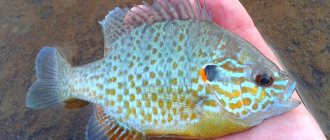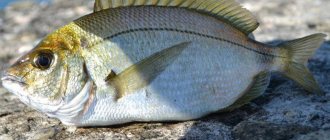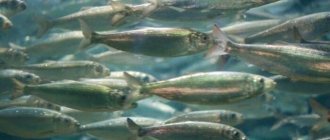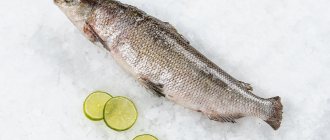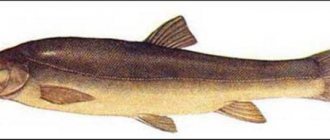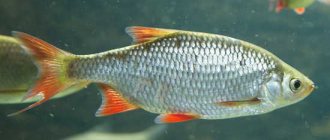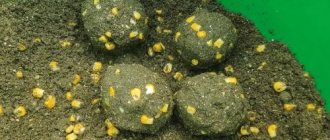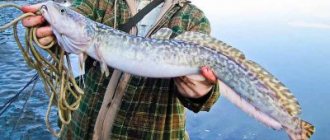Burbot is a unique species of fish. Until recently, it belonged to the cod family. But recently, when the existing system of fish classification changed under pressure from the results of genetic analysis, an independent family of burbot was introduced. Burbot is the only freshwater representative of this family. All other species live in the seas. Some species are familiar to our fishermen from the expedition to the Norwegian fjords.
As you can see in the photo, burbot fish are not difficult to recognize, although most fishermen do not encounter them. At the moment when the marble body with a wide head is on the hook, one glance at the lower jaw is enough. If there is a typical common feature of fish of the cod and burbot families - a single mustache sticking forward - you have a burbot.
Burbot is characterized by a relatively atypical arrangement of fins. It has two dorsal fins. Immediately after the 1st short fin follows the 2nd fin, located from half the length of the body to the tail. The anal fin is slightly shorter, so a wide fin “rim” is formed around the back of the burbot’s body, allowing it to bend in the water.
An unusual characteristic is the placement of the pelvic fins, which are significantly shifted forward, located in front of the level of the pectoral fins. Their lower ends fray into separate compartments, reminiscent of tiny hands. In the resting position, the burbot rests on the bottom.
The burbot's mouth is spacious, which indicates its predatory lifestyle. In this regard, we are talking about omnivorous fish. Few species of fish surpass it.
The color of burbot is a separate chapter. In addition to the classic marbled pattern, there are almost monochromatic, light and dark species, or fish with several distinctive pigment spots on a plain background. An interesting example of the color variability of burbot is the almost white fish from the Danube.
Burbot size
Burbot grows quite quickly. The reason for the rapid growth is nutrition even in winter. Ideal conditions for its growth are in large bodies of water with year-round low water temperatures. In lakes, burbot reaches sizes that cannot be compared with the growth opportunities found in other European areas. The size of burbot reaches more than 1 m in length and 10 kg in weight. Unlike Russian reservoirs, the largest representatives of burbot caught in other territories weighed about 4.5 kg. The most commonly recorded length was about 70 cm and the weight was 2-3 kg.
What does burbot fish look like?
Burbot is an unusual fish; it looks very specific and it is unlikely that anyone will confuse it with any other inhabitant of water bodies. Representatives of this species have a highly elongated spindle-shaped body, noticeably narrowing towards the tail. The head of individuals is flat with small yellow eyes. The mouth is of a relatively small lower type, filled with bristly teeth. At the end of the lower jaw, the fish has a process somewhat similar to the mustache of the largest inhabitant of freshwater bodies - the catfish. On the “nose” there are two short probe antennas.
The entire surface of the burbot's body is covered with small golden scales, under which there are mucus glands. The mucus makes it more maneuverable and mobile. The body color of representatives of the same species can vary dramatically depending on their habitat - from light brown to black. There are spots on the sides, a shade slightly darker than the main one, reminiscent of the color of a leopard.
The maximum length of burbot grown in its natural habitat reaches 120 cm, but such individuals are found sporadically and often in the northern regions. The average burbot is no more than 60 cm in length, and its weight rarely exceeds 3 kilograms.
Burbot habitats
Due to their marine origins, burbot habitats are widespread throughout the northern hemisphere. Its range covers almost the entire northern temperate zone. It ranges from the colder regions of Europe, passing through Siberia and Mongolia to Canada. In many habitats (eg burbot in Scandinavia) burbot is very common. Towards the south, the abundance of fish gradually decreases. The main reasons for the smaller number are the lack of water, the temperature and quality of which is conducive to the life and reproduction of burbot.
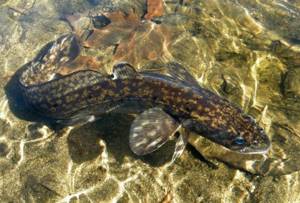
The fish's preference for cold is interesting. The temperature optimum lies below 10°C. At 15°C, burbot is already trying to leave the area. Therefore, it is not very active in summer. Burbot fishing increases significantly in the fall, reaching a peak in the winter, during the breeding season. Due to the temperature requirements that determine the distribution of burbot in the cold waters of Scandinavia and Russia, it is the main commercial species in these places.
Description
Burbot
The only freshwater fish from the order of codfish. The body of the burbot is elongated, rounded in the front and strongly compressed laterally in the back. The head is flattened, rather large, its length exceeds the maximum height of the body. The mouth is large, semi-inferior. The upper jaw reaches the vertical of the posterior edge of the eye. There are small bristle-like teeth on the jaws and partly on the vomer. The eyes are small. There is 1 short barbel at the anterior edge of the nostrils, and one barbel on the chin; its length is 20-30% of the length of the head.
Body color is variable and depends on living conditions, as in many species of fish. The back, sides and unpaired fins are dark brown or blackish-gray, with large brownish-yellow spots. The shape and size of the spots are very variable and slightly resemble the natural pattern of marble. The belly and paired fins are usually lighter in color. There are two dorsal fins: the front one is short, the back one is long. They are noticeably separated from each other. The anal fin is also long. The second dorsal and anal fins begin in the anterior half of the body and extend to the caudal fin. The caudal fin is rounded and separated from the unpaired fins by a small gap. The pectoral fins are rounded. The pelvic fins are located on the throat in front of the pectoral fins. The second ray of the ventral fin is extended into a long filament, equipped with sensitive cells, which are also present on the mental barbel. The scales are cycloid, very small, covering the entire body and, partly, the head. The lateral line is complete until the beginning of the caudal peduncle; further towards the tail it may be interrupted. Body covered with mucus
Age and size: large fish, can reach a weight of up to 24 kg and a length of 1.2 m. Age limit is 24 years.
The appearance and lifestyle of burbot indicate that it is a relict fish, preserved from the Ice Age. It inherited the cold-loving nature of its ancestors and lives mainly in water bodies of the northern hemisphere. Especially common in the rivers of Siberia.
Methods for catching burbot
How to catch burbot? In summer, the best way to catch burbot is on a cloudy day, with rising water. When fishing during the day, the success factor is muddy water. In winter, you can catch burbot all day (in cloudy weather), light snowfall is favorable. The burbot fishing season begins with the onset of the first frost and ends in late January – early February.
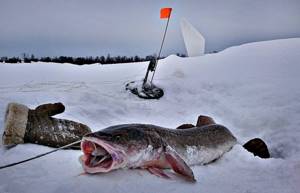
Fishing for burbot takes place in the standard way using a fishing rod with a float and bait at the bottom. The fishing rod is cast near possible shelters. In small bodies of water, fishing for burbot is carried out without a float, with periodic checking of the fishing rod (the caught burbot remains motionless).
Fish value
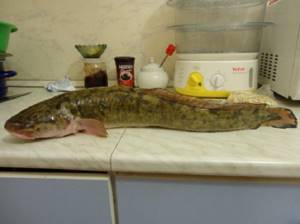
Burbot is a valuable commercial fish with good gastronomic qualities. From it you can prepare a variety of dishes with a memorable taste. The caught predator is fried, smoked, and stewed. Soups and broths are cooked from it, cutlets and meatballs are made.
Recommended reading: Autumn grayling fishing
Taste qualities
Among those who understand, burbot is considered a desirable fish. Fresh pulp has a pleasant sweetish taste and delicate texture.
On a note! In terms of taste, burbot meat is not inferior to marine representatives of the cod fish family - navaga, cod, molva, pollock, and mink. However, if the caught predator had to be put in the freezer, then after defrosting it becomes almost tasteless, acquires a fibrous structure and loses juices.
The fish has practically no small bones that cause inconvenience to the cook. It is usually not necessary to clean the carcass from dense scales. It is better to remove the head and throw it away, but the liver, caviar and milt, on the contrary, are of increased gastronomic interest.
Composition and calorie content
Burbot meat has a low calorie content, only 80 kcal per 100 grams of product. Protein is 18.8 g, and fat is only 0.6 g. It contains many useful microelements:
- zinc;
- manganese;
- iron;
- iodine;
- selenium;
- copper.
The meat contains vitamins A, D, E, B1, B6, B12.
What are the benefits of burbot for humans?
The meat of this representative of the ichthyofauna is indicated for people who adhere to a low-calorie diet. It is included in the weight loss menu. In addition, it is used in the diet of people diagnosed with heart disease and atherosclerosis.
Fish is good for children and teenagers. Burbot meat helps prevent ophthalmic diseases, increases the absorption of calcium by the body and tissue regeneration in case of injury. The vitamins contained in it affect the mental development of the child.
Contraindications
Burbot has no special restrictions on its use. It should not be eaten by persons:
- with allergic reactions to fish;
- in the presence of stones in the kidneys and gall bladder;
- with a high content of vitamins D in the body;
- with hypercalcemia.
In other cases, you should not limit yourself to consuming this predator.
The use of burbot in medicine
The benefits of the Mediterranean diet and the positive effects of a fish-eating culture have been known for a long time. The population in these areas rarely suffers from cardiovascular diseases, hypertension, malignant neoplasms, and diabetes. Scientists have proven that food, in particular fish, is a positive factor in good health. Burbot, like most fish, contains substances important for the body.
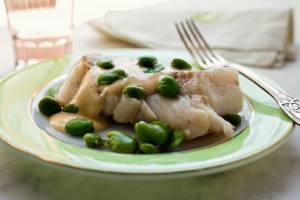
In medicine, burbot is especially valuable for its content of essential fatty acids omega-3, EPA (eicosapentaenoic acid) and DHA (docosahexaenoic acid). These acids inhibit the synthesis of inflammatory mediators, prostaglandins and leukotrienes, formed from linoleic and arachidonic acid. The positive results of consuming burbot are protection against cardiovascular diseases and elimination of inflammation in the body.
The effect of burbot meat on the body:
- consumption of this fish is recommended for idiopathic intestinal diseases, rheumatism, psoriasis;
- burbot contains valuable minerals and trace elements, in particular iodine and selenium. Selenium is a substance that protects the body from heavy metals, important for the antioxidant activity of glutathione tripeptide;
- For the human body, the presence in burbot of fat-soluble vitamins A, D, E, K, and B-complex vitamins, including B12, is important;
- 150-200 g of fish provide the daily recommended dose of selenium, iodine, B-complex vitamins;
- burbot contains high-quality proteins and fats. Fish proteins have high biological value, are easily digestible, reduce blood pressure, affect the cardiovascular system, and supply the body with essential amino acids (threonine, valine, leucine, lysine, tryptophan).
Burbot also contains the following substances:
- taurine (essential amino acid) – plays an important role in fat metabolism, stabilization of cellular lipid membranes, and acts as an antioxidant;
- lipophilic fat-soluble vitamins, mainly carotenoids, EPA, DHA;
- hydrophilic water-soluble vitamins (B).
Burbot meat is easily digestible and contains proteins that are beneficial for the body. It does not contain fibrous cellulose or stromal proteins (collagen, elastin). This is its main difference from shellfish (squid, cuttlefish), due to which it can be subjected to short-term heat treatment.
Burbot fish contains at least half water, almost 10-30% are proteins and fats. Due to the high water content, burbot meat undergoes rapid microbial degradation, which increases the content of histamine and biogenic amines. For this reason, it is not a good food for people with histamine intolerance. It is recommended to consume burbot fresh or freeze it as soon as possible after catching.
Habits and habitat
Burbot is an inhabitant of fresh water bodies, mostly a river species. Prefers to settle in rivers flowing into the Arctic Ocean. At low temperatures of the surrounding liquid it becomes more active. When the water temperature rises, it goes deeper. Burbot tries to find cooler areas even in cold water bodies. If there are none, it stays closer to the bottom, settling in snags, holes, among piles of stones. It avoids heavily silted areas because it is poorly oriented in muddy water.
The remains of this fish were discovered in the British Isles, Belgium, and Germany. The species was exterminated in these countries, and is now being artificially restored. In Holland the species is rare; in Austria and France it is considered vulnerable.
In fresh water bodies of Sweden, Latvia, Lithuania, Estonia, Finland and Norway, populations of this fish are large. However, in Finland and Sweden, the number of these underwater inhabitants is declining because their natural habitat is gradually being destroyed. In Eastern European countries, the number of the species is also gradually declining. Burbots are found in Slovenia, the Czech Republic, Bulgaria, Hungary, and Poland.
This type of fish is widespread in Mongolia and China. There are many of them in Russia: in reservoirs of zones with arctic and temperate climates, burbot is found throughout.
Where is Burbot found according to real reports from fishermen?
Mainly nocturnal.
Bright light irritates sensitive eyes, so during the day the predator is inactive, hiding among stones, snags, and in the burrows of other underwater animals. Prefers to take a head-out position. If the water warms up warmer than 12 °C, it becomes sluggish and inactive. The fish's appetite decreases. The torpor goes away during periods of cold weather, during which time the fish actively hunts. If the temperature rises above +21...+22°C, the fish will die. Burbot shows interest in surrounding sounds. Thanks to good hearing, he can pick up noises whose source is far away. To find out what caused the sound, animals can travel long distances.
Features of spawning
Burbot spawning occurs from late December to February. The water should cool to +1°C. Since the necessary conditions are not always created in the temperate zone, the fish has developed the ability for parthenogenesis: even an unfertilized clutch can develop fully.
For fish breeding, areas with shallow depths are chosen. The bottom should be rocky, pebble or sand. To find a suitable site, individuals can migrate long distances. Often they swim to the place where they themselves were born. First, large individuals swim to the spawning area. They lay eggs in small groups of 15-20 fish. Medium-sized individuals also spawn in small flocks. Small ones come to spawn in large groups of 50-100 fish.
The caviar is oily and has good buoyancy. Part of the masonry drifts with the current and is carried to different parts of the reservoir. The characteristics of different areas differ, so the chance of survival of the genus increases: part of the eggs will fall into conditions suitable for development.
What does it eat?
You can make a long list of what burbot eats. This predator is indiscriminate in its diet; its diet includes other species of fish, lampreys, crustaceans, frogs, and it can also eat carrion. The young eat the eggs of other species, amphibians, fry, small crustaceans, mollusks, leeches, worms, and insect larvae. Burbot is capable of swallowing prey the size of which is a third of its length.
Where does it live in Russia?
The rivers of the Arctic Ocean are considered the birthplace of burbot. However, its habitat in wildlife is quite wide: it includes reservoirs of the Arctic and temperate natural zones. These are basins of several seas (Barents, Baltic, White, Caspian, Black, Yellow), and Siberian rivers (Yenisei, Irtysh, Lena, Ob, Ufa, Chasovaya, etc.). This predatory fish also lives in lakes, the largest of them :
- Baikal;
- Taimyr;
- Teletskoye;
- Tavatuy;
- Zaisan.
